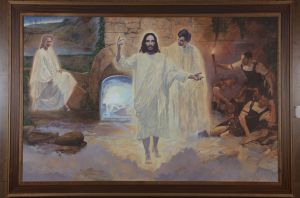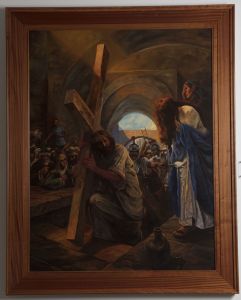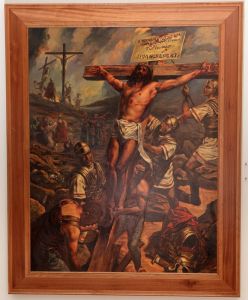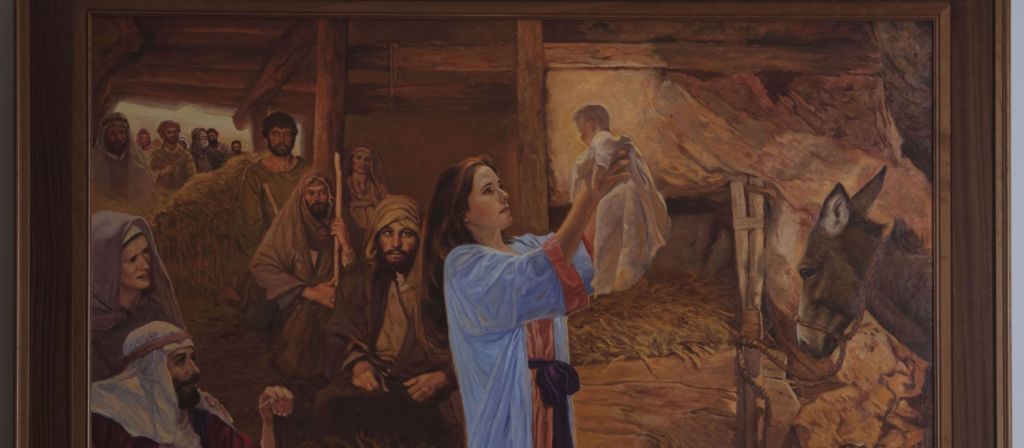He flew transport planes in World War II and the Korean War. He was a decorated war hero and a self- taught painter. He was a man who lost his faith and found it again.
Robert Wilson Sr. did it all and then painted the life of the man who saved his soul. His most famous body of work, the 21-piece “Life of Christ” series, was donated to Liberty University in 2016 and is displayed in the Montview Alumni Ballroom.
The art was donated to Liberty in the honor of the original buyers: the late Troy Day and Alton Thigpen. Some pieces were under their ownership for over 30 years before being donated to Liberty.
Wilson taught himself how to paint at a young age, growing to love the sharp, defined visuals of realism over any other painting style. His talent with a paintbrush quickly took a backseat after he passed the army’s test to be a pilot in World War II. When Wilson’s deployment ended, he moved to Woodruff, South Carolina, and began to design labels for a small packaging company.
Wilson returned to the military during the Korean War and later retired in 1963 after 23 years of service in the Army Air Corps and Air Force. His wife Marjorie Wilson — a devout Christian — noticed how his lack of faith was beginning to change him as a person, and she told him to paint the life of Christ as a method of finding his faith once more.
Thus, Wilson began to paint.

Photo by Jessie Rodgers
Jeff Hesla, one of Wilson’s art agents, has specific insight into how Wilson honed his painting skills and where he got inspiration.
“After he started reading the Bible again to regain his faith, he really liked Salvador Dalí and Norman Rockwell, so he traveled to Washington and asked if he could take photographs of Salvador’s ‘Last Supper,’” Hesla said. “He was trying to understand the shadows and the light and how Salvador Dalí did that in the painting.”
Wilson structured his work around used photographs, models and written descriptions, hoping to bring scenes to life and provide visuals for Gospel stories that had none. His first series of paintings focused primarily on the crucifixion of Jesus, but even throughout that creation process, Wilson painted other works too.
His works ranged from realist works of the Revolutionary and Civil Wars to aviation and portraits of leaders. Wilson was beginning to expand his art collection outside of the early “Life of Christ” paintings.
After gaining widespread acclaim and attention throughout South Carolina in the mid-1970s, his first series of artwork went on display at the Washington, D.C. National Prayer Breakfast for President Jimmy Carter in 1978.

Photo by Jessie Rodgers
Wilson’s early paintings were very dark, especially in contrast to the bright and vibrant colors of later pieces like “Risen” in 1988. Not only do they tell the story of Jesus, but they also show Wilson’s religious reawakening.
“Bob had a very hard time during those dark paintings. They are dark because he was feeling that way on the inside,” Hesla said. “After that event, the tour in South Carolina had some stops in major cities. Some gentlemen from Charlotte decided they wanted Bob to finish painting the entire New Testament — in other words, finish the story.”
The men in Charlotte were Day and Thigpen. After purchasing the present artwork, they commissioned Wilson to finish Jesus’ story. It was then when Wilson realized the paintings had taken on a different mission.
Wilson painted and painted, with Day and Thigpen collecting piece after piece as they were completed and showcasing them in Earl Owensby’s religious museum in Shelby, North Carolina. After a three-decades-long collection process and the passing of Thigpen in 2012, Day and Thigpen’s families began to seek out a new home for the artwork.

Photo by Leah Seavers
Liberty Art Museum director and art professor Todd Smith was sent to North Carolina to see the artwork and determine if it would be a good fit for Liberty’s art collection.
“The whole collection was still there. When I saw the collection, I was blown away by the quality and the size of the work,” Smith said. “I met with the families, and the decision was made to gift (the artwork) to the university.”
The artwork made its way to the school as a donation in 2016 and was dedicated Oct. 28 of the same year.
“I think (the paintings are) great forms of evangelism, but I also think they provide an opportunity for viewers to consider how Robert Wilson used his artistic gifts to reflect God’s creativity and bring him glory,” Smith said. “As one of the many cultural hubs in Lynchburg, one of the goals of the Museum is to add to the aesthetic tapestry of the community.
Wilson’s work can be viewed in the Montview Alumni Ballroom from 12 to 3 p.m. on Wednesdays. To learn more information about Wilson’s work, visit their website.
Napier is a feature reporter for the Liberty Champion
